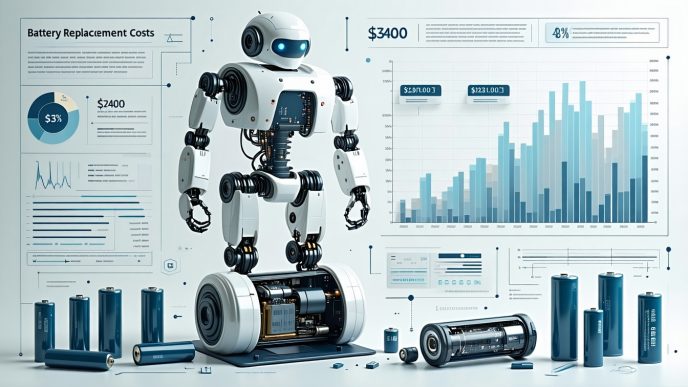Understanding Extended Warranties
What are Extended Warranties?
Extended warranties are service contracts that provide coverage for repairs and replacements beyond the manufacturer’s warranty period. They are designed to protect consumers from unexpected costs associated with malfunctioning or damaged products, such as home robots. These warranties can offer peace of mind for first-time buyers and value-conscious shoppers, ensuring that they do not bear significant repair costs shortly after their purchase.
Extended warranties for robots often cover specific components like batteries, sensors, and, in some cases, software updates. The length of coverage can vary significantly, typically ranging from one to three years after the original warranty expires. It is important for buyers to understand what is included in the warranty and any exclusions that might apply.
How Extended Warranties Work
Extended warranties operate in a straightforward manner. After purchasing a home robot and its respective warranty, the buyer pays a premium based either on a one-time payment or as monthly installments. In the event of a malfunction or other eligible issues, the owner can file a claim, which may require documentation of the problem.
The table below outlines common aspects of how extended warranties work:
| Aspect | Description |
|---|---|
| Coverage Duration | Typically one to three years after the original warranty period. |
| Payment Structure | One-time fee or monthly installments. |
| Claim Process | Submit a claim with proof of the issue. |
| Service Providers | Coverage may only be valid through specific providers or manufacturers. |
| Repair Options | Can include parts replacement and repairs at authorized service centers. |
Understanding the claims process is crucial for a buyer. Claims may require quick action and adherence to specific protocols to be successful. Potential buyers should consider guidance and tips on the cost of ownership for home robots to evaluate whether extended warranties are a suitable investment for them in the long term.
Awareness of costs such as repair and part replacement expenses, energy costs of running home robots, and battery replacement costs is essential. By weighing these variables, buyers can make informed decisions about their warranty options and overall expenditure. For further insights, exploring articles on robot maintenance costs and hidden costs in robot ownership can be beneficial.
Factors to Consider Before Purchasing
Before deciding on whether to invest in an extended warranty for a home robot, several important factors need to be assessed to ensure a well-informed decision. These include a cost analysis of the robot against the warranty, the reliability and durability of the robot, and the options available for repair and replacement without a warranty.
Cost Analysis: Robot Price vs. Warranty Cost
A thorough cost analysis helps potential buyers understand the overall investment involved in purchasing a robot and an extended warranty. Below is a comparison of typical price ranges for various types of robots along with costs of extended warranties.
| Robot Type | Price Range ($) | Extended Warranty Cost ($) |
|---|---|---|
| Robotic Vacuum | 200 – 800 | 50 – 150 |
| Robotic Lawn Mower | 600 – 3,000 | 100 – 300 |
| Home Cleaning Robot | 300 – 1,500 | 80 – 200 |
Evaluating these costs in relation to the expected lifespan of the robot can provide insights into whether an extended warranty is a prudent investment. For details on cumulative expenses, see our article on cost of ownership for home robots.
Reliability and Durability of the Robot
The reliability and durability of a specific robot play a critical role in determining the necessity of an extended warranty. Researching customer reviews and reliability reports can offer valuable information on this aspect. A robot with a history of longevity and minimal issues might not necessitate a warranty as much as a lesser-known model with frequent complaints.
Additionally, understanding how certain models have performed in terms of wear and tear can help inform future maintenance costs. For information on ongoing maintenance, refer to our article on robot maintenance costs.
Repair and Replacement Options Without Warranty
Considering repair and replacement options without an extended warranty is essential. There are various avenues to explore, which may impact the cost of ownership. Here are some options to consider:
| Repair/Replacement Option | Typical Cost ($) |
|---|---|
| Robot Software Subscription Fees | 20 – 100 annually |
| Battery Replacement Costs | 30 – 150 |
| Robot Repair and Part Replacement Expenses | 50 – 200 |
Understanding the potential repair and replacement costs can help buyers gauge the likelihood of needing a warranty. If out-of-pocket expenses seem manageable compared to warranty costs, it might influence their decision. For more insights on robot repairs, visit robot repair and part replacement expenses.
Evaluating these factors thoroughly can help clarify the true long-term costs associated with owning a robot and whether extended warranties for robots are worth the investment.
Pros and Cons of Extended Warranties
When considering the purchase of extended warranties for robots, it is essential to weigh both the advantages and disadvantages. Understanding these aspects can help inform the decision-making process for first-time buyers, value-conscious shoppers, and tech enthusiasts.
Benefits of Extended Warranties
Extended warranties can offer several advantages that provide peace of mind and financial protection. Some key benefits include:
| Benefit | Description |
|---|---|
| Financial Protection | Extended warranties can cover repair costs that may arise due to mechanical failures or defects, potentially saving a significant amount of money. |
| Convenience | Many warranties include repairs or replacements promptly without the need for extensive hassle on the owner’s part. |
| Budgeting | Knowing that certain repairs are covered allows for better financial planning, making it easier to budget for the costs of ownership. |
| Enhanced Resale Value | Transferrable warranties can make a home robot more appealing to potential buyers if the owner decides to sell. |
For more information on overall costs associated with robot ownership, refer to our article on cost of ownership for home robots.
Drawbacks of Extended Warranties
While there are benefits, there are also drawbacks to consider when deciding on extended warranties for robots:
| Drawback | Description |
|---|---|
| Initial Cost | The upfront expense of an extended warranty can be substantial, sometimes adding a significant percentage to the total cost of the robot. |
| Coverage Limitations | Some warranties may not cover all types of damages or issues, leading to unexpected expenses. |
| Complexity | Understanding the terms of warranties can be challenging, which may lead to confusion about what is and isn’t covered. |
| Potential for Overlap | If the robot comes with a manufacturer’s warranty, the extended warranty may overlap, resulting in unnecessary spending. |
For an in-depth understanding of potential future costs related to robot ownership, such as robot maintenance costs and battery replacement costs for robots, exploring these resources can further aid in the decision-making process.
Making an Informed Decision
When considering the purchase of an extended warranty for robots, it is essential to evaluate various aspects that impact both the initial investment and the long-term cost of ownership.
Assessing Your Needs and Usage
Evaluating personal needs and usage patterns is crucial in determining if an extended warranty is a worthwhile investment. First-time buyers should consider how often they plan to use the robot and in what environments. Below is a table summarizing common usage scenarios:
| Usage Scenario | Frequency | Impact on Warranty Decision |
|---|---|---|
| Daily use in high-traffic areas | Daily (high impact) | Higher likelihood of wear and tear |
| Weekly cleaning in low-traffic areas | Weekly (moderate impact) | May not need extended coverage |
| Seasonal use | Few times a year | Generally lower risk and cost |
Buyers should also reflect on their comfort level with potential repairs and maintenance. Those who regularly engage in DIY repairs may opt for a warranty-less approach.
Researching Warranty Providers
Not all warranty providers offer the same level of coverage or service quality. It is essential to research various providers to find the most suitable option. Some points to consider include:
- Coverage specifics: Does the warranty cover parts, labor, or both?
- Claim process: How simple is the process of filing a claim?
- Customer reviews: What do other users say about their experiences with the provider?
Compile a comparison chart of warranty providers to aid decision-making:
| Provider | Coverage Type | Claim Process | Customer Rating |
|---|---|---|---|
| Provider A | Parts & Labor | Online submission | 4.5/5 |
| Provider B | Parts only | Phone support | 4.0/5 |
| Provider C | Labor only | In-person claims | 3.5/5 |
For further insights on managing costs effectively, refer to our article on cost of ownership for home robots.
Understanding Terms and Conditions
Before committing to an extended warranty, buyers should thoroughly review the terms and conditions. Key aspects to analyze include:
- Exclusions: What situations are not covered by the warranty? For instance, accidental damage may not be included.
- Duration of Coverage: How long is the warranty valid? Does it align with the expected lifespan of the robot?
- Transferability: Can the warranty be transferred if you decide to sell the robot in the future?
Being aware of these terms can prevent frustration and unexpected costs later on. This diligence is especially important when considering additional expenses associated with robot ownership, such as robot maintenance costs and energy costs of running home robots.
By carefully assessing individual needs, researching warranty options, and understanding coverage terms, potential buyers can make informed choices about extended warranties for robots.
Alternatives to Extended Warranties
For those considering extended warranties for robots, exploring alternatives can provide peace of mind and potentially save money in the long run. Below are several options to consider.
DIY Repairs and Troubleshooting
Many common issues with home robots can be resolved through do-it-yourself repairs or troubleshooting. Familiarizing oneself with basic maintenance procedures can prevent minor problems from escalating and extend the life of the device.
Common DIY repair tasks may include:
- Cleaning sensors and brushes
- Replacing filters
- Updating software
Online resources, such as forums or instructional videos, can guide individuals through these processes. Understanding robot maintenance costs is essential, as simple repairs often require minimal investment compared to the costs associated with extended warranties. Explore further details on robot maintenance costs for better insights.
Third-Party Service Providers
Another viable alternative to extended warranties is utilizing third-party service providers. These technicians can often repair robots at a lower cost than manufacturer services, providing flexibility without compromising quality. When selecting a provider, ensure they have experience with the specific type of robot and check their reviews for reliability.
Consider the following when evaluating third-party services:
| Aspect | Considerations |
|---|---|
| Cost | Typically lower than manufacturer repair fees |
| Expertise | Look for specialists knowledgeable in robot technology |
| Warranty | Some services may offer guarantees on repairs |
Researching local options can lead to substantial savings. If repair and part replacement expenses arise, it may be more cost-effective to consult an independent technician. To understand more about these expenses, visit our article on robot repair and part replacement expenses.
Consumer Protection Laws
Consumer protection laws vary by region but generally provide rights and safeguards to consumers regarding product warranties and repairs. Familiarizing oneself with these laws can offer additional security for home robot purchases.
Key points to consider:
- Most jurisdictions require reasonable repair times and quality parts for warranty claims.
- Some laws protect users against undisclosed fees or repair terms.
- Understanding the rights associated with purchase can help consumers make informed decisions.
To delve deeper into how these laws may impact a purchase, investigate applicable statutes in your area. This knowledge could substantially influence decisions regarding warranties or alternative options.
For those concerned about the overall cost of robot ownership, consider accounting for various factors beyond initial purchases, such as energy costs of running home robots and battery replacement costs for robots. By fully understanding these aspects, individuals can navigate the true cost of ownership effectively.















